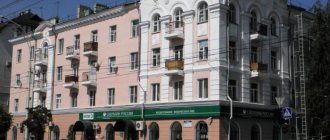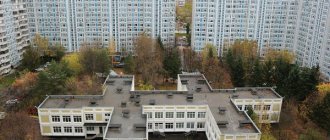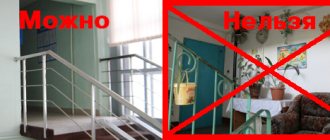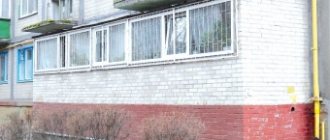The modern metropolis serves as a center of attraction for residents of small towns, villages and villages. Here it is easier to get a good education and find a job with decent pay. As a result, the demand for housing in large cities is constantly increasing, and with it the number of floors of new buildings is also growing.
When choosing an apartment, new residents have to decide a very important question: which floor is better to live on, where they will feel safe and comfortable. Let’s figure out what criteria people use to choose a place to live at a particular altitude.
Advantages and disadvantages
It is almost impossible to determine once and for all on which floor it is better to buy an apartment, so as not to regret your choice. The fact is that there are a huge number of nuances that will have to be taken into account. These include the composition of the family, the age of its members, and the area of residence. Each option has pros and cons, so you need to strive for a compromise that will suit future residents in several basic parameters.
First floor
An apartment on the ground floor has its pros and cons. The words “do not offer first and last” became classics of apartment advertisements a long time ago, and many people choosing new housing adhere to the same principle.
The roots of this prejudice should again be sought in the Soviet past:
- Many houses do not have a basement level, so the floors of ground floor apartments practically lie on the ground. If we remember that during the period of mass construction of housing 40-50 years ago, they did not think much about high-quality thermal insulation, it becomes clear that apartments on the first floor are rarely warm - there is an unheated basement below.
- The windows are accessible from the street; intruders can get inside without any problems. This forces you to purchase window bars, which is not always acceptable from an aesthetic point of view and is fraught with additional costs. Moreover, in the event of a fire, such a barrier can work against the residents themselves: it will be difficult to escape through the window.
- The first level of old houses does not provide for a balcony. For many, this is a definite disadvantage.
- Open windows become a source of constant noise and exhaust fumes from passing cars. The front door to the entrance also adds unpleasant sounds at any time of the day.
- As a rule, the lower residents suffer from a lack of sunlight: it is blocked either by neighboring houses or by the crowns of trees.
It’s clear that the first one is bad, however, living on the lower level of the building also has its advantages.
The following circumstances can be considered a clear advantage:
- Owners of lower apartments do not have to walk up the stairs. This is especially appreciated by elderly residents and parents with small children. It is quite difficult for many pensioners to overcome the distance even to the fifth floor, and it is not easy for young people to lift a stroller or bicycle. If we talk about taller buildings, the problem of elevators that often fail is also quite relevant.
- If the house is located in a quiet side street, residents may well acquire their own front garden: sow a lawn, plant flowers and shrubs. Such a green corner will allow not only the residents themselves to enjoy a pleasant view from the window and clean air, but will also delight all residents of the entrance and guests of the yard.
However, all of the listed disadvantages apply to houses built several decades ago. Modern projects of residential buildings provide for the placement of commercial areas on the lowest tier - shops, beauty salons, workshops providing personal services. This automatically moves the first residential level to the next level.
Second
For many, this seems like an unacceptable option, and there are reasons for this. If the first level of the building is given over to shops, hairdressers and cafes, residents of the second may be disturbed by the noise associated with the activities of these establishments.
Many of the disadvantages of the lower level are also relevant here: street noise is no less audible, and in some houses there is also a need to protect windows from thieves with bars.
The advantage can be considered independence from the elevator and better thermal insulation compared to the first. In addition, the cost of such apartments is usually lower, which for many can be a decisive argument in favor of purchasing housing on the first or second floor.
From third to seventh
Buyers are primarily interested in apartments in this range, especially when it comes to nine-story buildings. This is the so-called golden mean - floors with a minimum number of shortcomings.
There really are a lot of advantages:
- Sufficient height distance from the roadway protects from exhaust gases.
- There are no problems with lighting, especially above the fourth or fifth floor: trees with spreading crowns are usually not so tall.
- The middle levels are far from both the basement and the roof. This eliminates problems associated with roof leaks and flooding of technical rooms.
- Not too far from the ground to experience the negative effects of living on very high floors: from psychological (fear of heights) to well-being problems.
The disadvantages include the need to climb on foot if the elevator does not work, but this situation is the exception rather than the rule.
From eighth to sixteenth
The advantages of living at this level are obvious. Excellent visibility, good lighting, complete absence of exhaust gases and muffled street noise - all this makes life at altitude attractive for many people.
Opponents of purchasing such apartments, as a rule, are elderly people, who will find it difficult to go up and down home in case of problems with the elevator. For the same reason, families with small children avoid settling here. There are those who are simply afraid of heights. For them, the best option when thinking about which floor to choose in a 17-story building will be the first.
But for a huge number of residents of megacities, living at an altitude of 30-40 meters above the ground is an opportunity to spend time comfortably, take a break from work, and enjoy city views while standing on the balcony.
It is worth noting that any of the floors from the eighth to the sixteenth can be the topmost in the house. In this case, certain disadvantages accompany them.
The last residential level is not in high demand for several reasons:
- In Soviet-era houses there are problems with water pressure: upstairs it flows from the tap with weak pressure.
- In the absence of a technical floor, the roof may leak, as a result of which the upper apartments suffer.
- Encroachment on property by high-rise thieves is also quite likely.
- You will have to ventilate the heating system, that is, provide access to the pipes to utility workers.
In some houses, the project provides for the arrangement of space under the roof for housing. The result is premises that are popularly called two-story apartments: the lower tier is the last floor of the house, and the upper one is converted from an attic.
Higher
Typical residential buildings, as a rule, have no more than 25 floors. Of course, there are unique projects with 50 or even 70 levels. Living in an apartment at a dizzying height is more a matter of prestige than comfort. The owners of such apartments clearly prefer to spend more time in country cottages than on the same level with birds.
Status and the desire to fit in with one's surroundings have little to do with real convenience. In addition, we are talking about several premium real estate properties, including the Moscow City buildings or the Na Mosfilmovskaya residential complex.
Corner apartments
Housing located at the ends of the building is valued less by real estate buyers than those located in the middle. The main disadvantage is that one wall faces directly onto the street, freezes, gets wet under snow and rain. This means that in winter these apartments are much colder compared to the rest of the house.
This mostly applies to panel houses built in the 70s and 90s. Today, owners often take independent steps to improve thermal insulation by applying a layer of insulation to the external wall. This spoils the overall appearance of the building, but saves residents from cold, humidity and fungal damage to the walls.
Upper floor apartments
Housing on the upper multi-storey levels in urban buildings is attractive to buyers looking for panoramic views from their windows. The exception is the last floor and especially in the old housing stock, where there is no technical floor between the last residential level and the roof.
The disadvantages of the upper tiers of an apartment building are associated with the remoteness of the residential premises from the ground, which is why the living comfort of the residents directly depends on the serviceability of the elevator. If the elevator equipment breaks down, going up, for example, to the 17th floor even once a day is already a small feat.
Another negative point is the increased wind load, especially if there are no other high-rise buildings near the high-rise building. And the higher the apartment is located, the more difficult it is to perceive height. Some citizens are frightened by the very thought of going out onto the 17th floor balcony.
Next up are the advantages of the upper floors; they are quite significant. The higher the apartment is, the cleaner the air near its windows. Dust and dirt usually reach the lower floors. Street noise does not reach the upper residential levels of the apartment building. With climbing skills, attackers can theoretically get through the windows of apartments on the upper floors, but it is impossible to do this secretly.
What factors to consider when choosing
Previously, we talked about the most obvious reasons that people use when determining the optimal floor for purchasing an apartment. However, there are factors that are not on the surface, but greatly influence the quality of life. Let's focus on the most significant ones.
Air pollution
It is no secret that the ecology of large cities is far from ideal. Sources of air pollution include a huge number of cars and exhaust from industrial enterprises. To protect yourself completely from such a negative impact is an almost impossible task, but you can still try to reduce its level.
It is better not to consider busy avenues, streets with heavy traffic and highways as a place of residence. If there is no other option, then you should choose apartments as high as possible from the ground. Exhaust gases are heavier than air, so their concentration is maximum at the level of the first and second floors.
But life at altitude can also be dangerous if thermal power plants, waste treatment plants and other industrial enterprises are located in the immediate vicinity. Smoke from chimneys spreads at the level of the upper floors, especially if the wind rose contributes to this.
Noise level
If we talk about the hum of cars, without which it is difficult to imagine the life of a large city, then it is felt less on the ground floors. It's all about sound propagation at a certain angle, due to which it bypasses the area of the lower levels of buildings. Trees and shrubs planted along houses also help reduce noise below.
From this point of view, experts consider it optimal to live on the fourth or fifth floors. Trees usually don’t grow higher, so you’ll have to escape the constant hum behind triple-glazed windows.
Radon
There is another negative factor: danger that is invisible to the eye and inaccessible to other senses. We are talking about radon, a radioactive gas that accumulates in the basements of residential buildings. 90% of it comes from the earth's crust; a small amount can be released from building materials and artesian water.
To reduce radon concentrations, forced ventilation of basements is necessary. Otherwise, residents of the lower floors are at risk of developing various chronic diseases and lung cancer as a result of prolonged exposure.
Electromagnetic radiation
Modern apartments are equipped with a variety of household appliances. The electromagnetic waves it emits are generally safe. However, experts are convinced that the reinforced concrete structures that make up panel houses interfere with their free circulation, directing the flows higher. As a result, the electromagnetic background of the upper floors often exceeds the norm. This can provoke headaches.
You can reduce the likelihood of the negative impact of such waves by giving preference to brick or brick-monolithic houses and middle floors. The presence of cell towers nearby is also a risk factor that should be avoided.
Lack of moisture and oxygen
There are not as many green spaces in the city as we would like. It is trees and shrubs that saturate the air with oxygen and increase its humidity. According to these vital indicators, the situation is better on the lower floors.
The higher you are from the ground, the lower the moisture and oxygen content in the air. This is fraught with drying out of the mucous membranes of the nose and oral cavity and the appearance of respiratory diseases. Lack of oxygen is detrimental to the cardiovascular system.
For residents of high-rise buildings, the situation is complicated by lower atmospheric pressure.
Mosquitoes
There are no fewer of these insects in urban areas than on the banks of a rural river on a summer evening. Cellars are places where mosquitoes gather in large numbers—high humidity and favorable temperatures encourage their reproduction all year round.
But if the presence of parasites on the ground floor can be explained by the close proximity to the source of their appearance, then ventilation and elevator shafts serve as the paths for mosquitoes to move on the upper levels of buildings. In search of a person, insects rise higher and higher, focusing on the smell of lactic acid, sweat and carbon dioxide.
Watch the video: Which floor is best for safe living
Why is the middle considered best?
Middle floors are deservedly in the highest demand among apartment buyers. People are willing to pay the developer more to live in comfort and safety.
The most attractive things about such apartments are:
- Equal distance from both the basement and the roof, and therefore from the problems associated with them.
- The ability to safely endure elevator shutdowns.
- Greatest chance of safe evacuation in case of fire.
- Sufficient lighting of the home.
Apartments in the middle also have disadvantages - the likelihood of a flood due to leaks is always higher, especially if the neighbors do not treat their plumbing equipment properly.
Middle floors from third to seventh
The most popular are mid-level apartments. Their advantages:
- No disadvantages of the first floors with a relatively small difference in price.
- The sun's rays penetrate the windows if it is not on the shady side. Noise and gas pollution from the street no longer cause inconvenience.
- It is quite possible to take the stairs to the apartment if there is a problem with the elevator.
But this also has its drawbacks:
- The higher the floor, the more problematic the climb. For example, for residents of 3-4 floors such a load is quite surmountable (even with a child, bags of groceries, etc.), but on higher floors this task is more difficult. Therefore, you will have to take into account your physical abilities and ability to climb stairs in the event of an elevator failure for a long time.
- In new buildings, in the first years after moving in, each owner makes adjustments to the repairs. On the middle floors you cannot avoid noise from all sides. Sound insulation in new houses, as a rule, leaves much to be desired.
Doctors' opinion
Doctors believe that a healthy person can live where he wants without problems, based on his own feelings. Doctors' recommendations on which floor is best to live on for health purposes apply to those who already have chronic diseases or have a genetic predisposition to them.
The medical advice is as follows:
- Dampness and lack of ventilation on the first floors cause frequent ARVI and further complications.
- Asthmatics and epileptics should stay no higher than the 7th floor.
- For patients with hypertension and disabilities, the lower levels of buildings are more suitable.
- Among chronic patients with cardiovascular problems, more are those who live on the ground floor. If you have a predisposition, then it is better to settle higher - on the fourth to sixth.
Of course, the most correct thing would be to consult with your doctor, who will give specific recommendations based on the patient’s condition and long-term prognosis for his well-being.
Precautions
The negative factors of living on the lower and upper floors were mentioned above. Residents of such apartments need to take some measures to minimize dangerous consequences.
Necessary:
- regularly ventilate rooms and ensure maximum possible access to sunlight,
- carry out preventive antifungal disinfection of walls,
- wash floors thoroughly two to three times a week,
- If you are close to a highway, get an air purifier and ionizer.
These measures will help reduce the likelihood of problems caused by proximity to the basement, high humidity and radon accumulation.
Owners of apartments on the upper floors have to contend with other negative aspects: dry air, lack of oxygen and electromagnetic waves.
To do this, they are recommended:
- buy a humidifier,
- install a powerful forced ventilation system,
- grow indoor plants to improve the indoor microclimate,
- spend more time in nature.
Following these simple recommendations will make life on any floor more comfortable and safer.
Floor and fire safety
Few people think about fire when buying an apartment, but fires in residential high-rise buildings do happen and are not uncommon. It is better to know in advance how high the fire escape reaches and from where you can be rescued. This information can save your life in a dangerous situation.
The longest fire escapes in Ukraine
According to firefighters, in Ukraine there is only one 90-meter ladder that can extinguish fires in high-rise new buildings. It is located only in Kyiv and will reach the 20-24th floor. In other million-plus cities there are no such stairs.
In the best case, there is one 50-meter ladder for the entire city that can extinguish a fire on the 12-13th floor of a residential building. This is the maximum height from which you can be rescued. But it’s too early to rejoice.
At best, there is only one such car for the whole city and it will take about an hour to get to you. Provided that at this moment it will not be used and will not get stuck in a traffic jam. During this time, not only the entire apartment will burn out, but also the upper floors of the building. Therefore, all floors from 10 to 13-14, although they can be saved, are in danger.
How to extinguish a fire on the 22nd floor of a new building
This is a well-known case in Odessa, when a house in the Gagarin Plaza residential complex burned down. The fire occurred on the top floor and the fire quickly spread throughout the entire façade. In Odessa there is simply no equipment capable of extinguishing such tall buildings. All floors above 12 are potentially very dangerous in case of fire.
The only way to escape on the upper floors of tall new buildings is a helicopter, but you understand, firefighters can only dream of a helicopter. This type of equipment is not used by firefighters. The fire in Odessa took 5 hours to extinguish. 80 percent of the apartments' facades burned down.
What equipment do firefighters have?
Firefighters commonly use equipment for extinguishing fires on floors no higher than 9. These are 30-meter ladders of fire trucks. In this case, the car will be able to arrive within 15 minutes and you have a great chance of surviving and remaining unharmed. The fire will be put out, and you will be able to go down the fire escape.
Conclusion which floor is better in case of fire
The best floor in case of fire in your house will be up to 9 inclusive. At least there are fire trucks in your area that can arrive quickly. Anything higher than nine can already create difficulties for firefighters.
And this is in ideal conditions, because usually our yards are filled with cars and the fire escape stretches from a long distance. So the 9th floor can also be potentially dangerous.
Tips and tricks
Every family faced with the choice of where to live will have to weigh a lot of pros and cons, listen to a lot of examples of successful and not so successful living on a particular floor. However, in general, it is worth proceeding from the most significant factors: the presence of the necessary infrastructure, clean air, the opportunity to walk and play sports.
The specific floor is a secondary matter; you can find positive aspects in living at any level.
Feng Shui fans
There are many who like to be guided by ancient Chinese teachings in everything, and when it comes to such a serious issue as choosing a floor, it is even more worth turning to Feng Shui.
The ancient Chinese believed that each number has its own energy.
The meanings of the main numbers according to Feng Shui:
- The unit carries positive energy, promises luck and success in all endeavors.
- A two can be translated as “easy”, it guarantees the absence of problems.
- The meaning of number three is promotion and growth. Suitable for those who are building a career or doing business.
- Four is interpreted as “death,” but this is not necessarily physical death; moving to the fourth floor can be regarded as the beginning of a new life.
- Five is a symbol of harmony and balance, but the hieroglyph itself translates as “nothing,” so it’s better not to take risks and choose another floor.
- The number six means wealth and stability, so there can be no doubt here.
- Seven is interpreted as calm and confidence; it will not cause trouble to residents.
- The eighth floor is the best floor to live in; success, wealth, and prosperity come together in this hieroglyph.
- The ninth is suitable for creative people who are ready to develop spiritually and physically.











